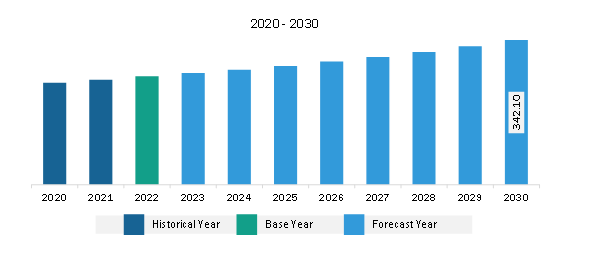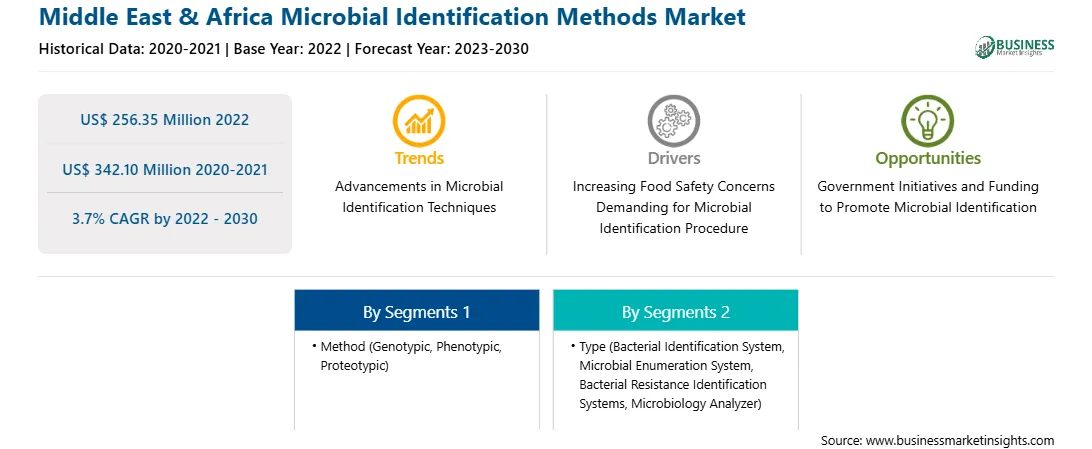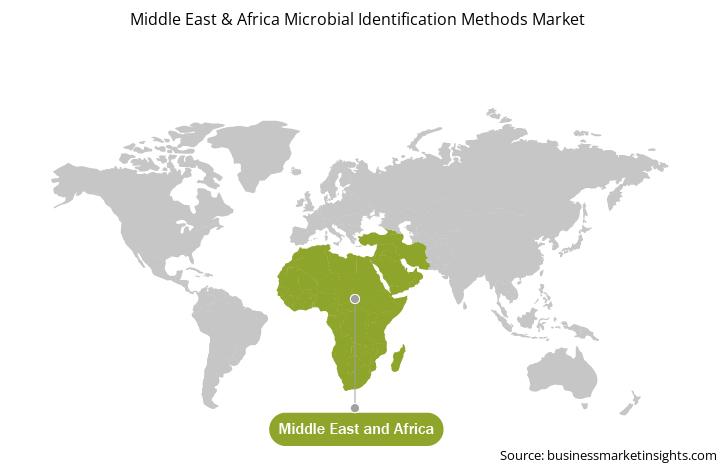The Middle East & Africa microbial identification methods market was valued at US$ 256.35 million in 2022 and is expected to reach US$ 342.10 million by 2030; it is estimated to grow at a CAGR of 3.7% from 2022 to 2030.
Government Initiatives and Funding to Promote Microbial Identification Fuel the Middle East & Africa Microbial Identification Methods Market
Government initiatives and funding promoting microbial identification are crucial pillars of public health, scientific research, and industrial development. These initiatives serve a wide range of purposes, from enhancing disease surveillance and response to supporting innovative research in microbiology. For instance, Antimicrobial Resistance (AMR) surveillance in the UAE was initially implemented in 2010 at the subnational level (Abu Dhabi Emirate, HAAD/DoH). In partnership with the UAE Ministry of Presidential Affairs (MOPA), Department of Health Abu Dhabi (DoH), Dubai Health Authority (DHA), and Abu Dhabi Public Health Center (ADPHC), the Ministry of Health and Prevention (MOHAP) built and expanded the system nationally in 2015. The WHO created the Global AMR Surveillance System (GLASS) in 2015, and the UAE National AMR surveillance system contributes to it by providing AMR data (WHO-GLASS, 2015). As of July 2022, clinical microbiology laboratories located throughout all seven UAE's Emirates served 44 of the 318 monitoring sites (consisting of 231 centers/clinics and 87 hospitals) that comprise the UAE AMR surveillance system. Furthermore, in 2015, Saudi Arabia's Ministry of Health (MOH) implemented antimicrobial containment and infection prevention and control programs in MOH hospitals after realizing the importance and impact of AMR. The five objectives of the WHO Global Action Plan on AMR were adopted by the country when it created its first AMR National Action Plan in 2017. The Kingdom's 2022 AMR plan places a strong emphasis on the necessity of an efficient One Health strategy that operates at the local, regional, national, and international levels; is cooperative, multisectoral, and transdisciplinary; and acknowledges the connections that exist between people, animals, agriculture, and the shared environment. In order to carry out the essential AMR actions that support the overarching objectives, the transdisciplinary stakeholders in the Kingdom will be able to work together within the framework of this plan. The objectives remain the same as those stated in 2017, although they are more focused now because of the Kingdom's current circumstances and the change in their scope. A National AMR Committee made up of specialists and scientists from related fields was founded in January 2017 to address AMR in the Kingdom. The 2022 strategy and action plan were developed with the Committee's assistance when it was reorganized in 2019. The interdisciplinary Committee's representatives and other stakeholders participated in one-on-one meetings and workshops as well as active engagement and consultation to achieve this. In addition, the 2022-2025 action plan focuses on the nation's efforts on addressing the gaps found and strengthening the work already done, including improving surveillance in humans, especially in animals and the environment, growing hospital-based AMR stewardship programs, consuming antibiotics in humans and animals, and making sure that AMR activities are rigorously monitored. Overall, these initiatives and funding mechanisms play a pivotal role in safeguarding public health, advancing scientific knowledge, and driving economic growth by underpinning the microbial identification field.
Middle East & Africa Microbial Identification Methods Market Overview
Saudi Arabia and the UAE have a stable economy, as a significant portion of the local market witnessed a strong performance in value terms in recent years. According to the Institute for Health Metrics and Evaluation, Saudi Arabia and South Africa have a high prevalence of lower respiratory infections such as acute bronchitis, pneumonia, and tracheitis. Furthermore, according to a study published (October 2020) in the International Journal of Pharmaceutical and Phytopharmacological Research (eIJPPR), acute lower respiratory tract infections (ALRTIs) affect ~15.4% of the Saudi Arabian population, and it is reported to be the most common diseases among children and infants. Additionally, the Middle East & Africa microbial identification methods market is significantly increasing due to the rising consumer awareness regarding the risks of bacterial infections from minor cuts, abrasions, and other small injuries among diabetic patients in Saudi Arabia. Similarly, South Africa has a high prevalence of infectious diseases such as bacterial meningitis and enteric fever. According to a study published (2023) in Frontiers, in Africa, studies describe incidence rates of bacterial meningitis between 0-40 per 100,000 per year. As per the same source, Sub-Saharan Africa is also called the "meningitis belt," as it has many meningitis cases. Epidemic meningococcal group A disease outbreaks have recorded incidence rates of up to 100 cases per 100,000 population. Thus, the prevalence of infectious diseases in the region is expected to boost diagnostics and pharmaceutical production, which will increase the application of microbial identification methods in the region. Further, in the last few years, the private sector has been a crucial part of the healthcare system in Saudi Arabia, with the rising investments in the development projects of healthcare facilities and infrastructure in the country. The government launched the Saudi Vision 2030 program with the aim to reduce oil dependence and diversify other sectors, including healthcare. Under this program, the Health Sector Transformation Program aims to reconstruct the healthcare sector as a comprehensive, effective, and integrated healthcare system based on the individual's health. Similarly, the UAE government strives to develop more strategies and improve the quality of healthcare and laboratory testing services in the country. The UAE offers a highly developed healthcare system with first-class facilities and the latest medical technology. Thus, the increasing investments in developing healthcare facilities and the high prevalence of lower respiratory infection among the population are likely to fuel the microbial identification methods market growth in the Middle East & Africa during the forecast period.
Middle East & Africa Microbial Identification Methods Market Revenue and Forecast to 2030 (US$ Million)

Strategic insights for the Middle East & Africa Microbial Identification Methods provides data-driven analysis of the industry landscape, including current trends, key players, and regional nuances. These insights offer actionable recommendations, enabling readers to differentiate themselves from competitors by identifying untapped segments or developing unique value propositions. Leveraging data analytics, these insights help industry players anticipate the market shifts, whether investors, manufacturers, or other stakeholders. A future-oriented perspective is essential, helping stakeholders anticipate market shifts and position themselves for long-term success in this dynamic region. Ultimately, effective strategic insights empower readers to make informed decisions that drive profitability and achieve their business objectives within the market.

| Report Attribute | Details |
|---|---|
| Market size in 2022 | US$ 256.35 Million |
| Market Size by 2030 | US$ 342.10 Million |
| Global CAGR (2022 - 2030) | 3.7% |
| Historical Data | 2020-2021 |
| Forecast period | 2023-2030 |
| Segments Covered |
By Method
|
| Regions and Countries Covered | Middle East and Africa
|
| Market leaders and key company profiles |
The geographic scope of the Middle East & Africa Microbial Identification Methods refers to the specific areas in which a business operates and competes. Understanding local distinctions, such as diverse consumer preferences (e.g., demand for specific plug types or battery backup durations), varying economic conditions, and regulatory environments, is crucial for tailoring strategies to specific markets. Businesses can expand their reach by identifying underserved areas or adapting their offerings to meet local demands. A clear market focus allows for more effective resource allocation, targeted marketing campaigns, and better positioning against local competitors, ultimately driving growth in those targeted areas.

Accelerate Diagnostics Inc, Avantor Inc, Becton Dickinson and Co, bioMérieux SA, Bruker Corp, Danaher Corp, Merck KGaA, Molzym GmbH & Co KG, Shimadzu Corp, Thermo Fisher Scientific Inc are some of the leading companies operating in the Middle East & Africa microbial identification methods market.
1. Accelerate Diagnostics Inc
2. Avantor Inc
3. Becton Dickinson and Co
4. bioMérieux SA
5. Bruker Corp
6. Danaher Corp
7. Merck KGaA
8. Molzym GmbH & Co KG
9. Shimadzu Corp
10. Thermo Fisher Scientific Inc
11. Biolog Inc.
The Middle East & Africa Microbial Identification Methods Market is valued at US$ 256.35 Million in 2022, it is projected to reach US$ 342.10 Million by 2030.
As per our report Middle East & Africa Microbial Identification Methods Market, the market size is valued at US$ 256.35 Million in 2022, projecting it to reach US$ 342.10 Million by 2030. This translates to a CAGR of approximately 3.7% during the forecast period.
The Middle East & Africa Microbial Identification Methods Market report typically cover these key segments-
The historic period, base year, and forecast period can vary slightly depending on the specific market research report. However, for the Middle East & Africa Microbial Identification Methods Market report:
The Middle East & Africa Microbial Identification Methods Market is populated by several key players, each contributing to its growth and innovation. Some of the major players include:
The Middle East & Africa Microbial Identification Methods Market report is valuable for diverse stakeholders, including:
Essentially, anyone involved in or considering involvement in the Middle East & Africa Microbial Identification Methods Market value chain can benefit from the information contained in a comprehensive market report.